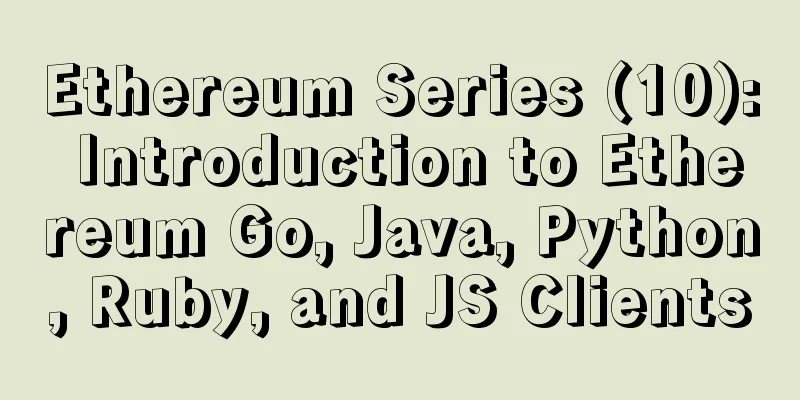Ethereum Series (10): Introduction to Ethereum Go, Java, Python, Ruby, and JS Clients

go-ethereumThe go-ethereum client is commonly referred to as geth, which is a command-line interface that executes a complete Ethereum node implemented in Go. By installing and running geth, you can participate in the Ethereum front-end real-time network and perform the following operations:
Link:
pyethappPyethapp is a Python-based client that implements the Ethereum cryptoeconomic state machine. The Python implementation aims to provide a code base that is easier to cut and extend. Pyethapp uses two core Ethereum components to implement the client:
Link:
ethereumjs-libAs stated in the yellow paper, ethereumjs-lib is a javascript library for core Ethereum functionality. It is a simple meta-module that provides the following modules. Most of the JS modules are tracked on ethereumjs.
Link:
Ethereum(J)Ethereum(J) is a pure Java implementation of the Ethereum protocol. It is provided as a library that can be embedded in any Java/Scala project and provides full support for the Ethereum protocol and ancillary services. Ethereum(J) was originally developed by Roman Mandeleil and is now funded by <ether.camp>. Ethereum(J) supports CPU mining. It is currently implemented in pure Java and can be used on private and test networks. You can even mine on the live Ethereum network, but it is not economically viable. Link:
ethereumHThis package provides tools written in Haskell that allow you to connect to the Ethereum blockchain. Link:
ParityParity claims to be the fastest and lightest client in the world. It is written in Rust, which enhances reliability, performance, and code clarity. Parity is developed by Ethcore. Ethcore was created by several members of the Ethereum Foundation.
Arch Linux packages are community maintained by Afri Schoedon and quininer.
Some people have reported success running Parity on a Raspberry Pi 2. ruby-ethereumruby-ethereum is an implementation of the Ethereum virtual machine, written in Ruby. Link:
Related:
References:For links to the list in the article, please refer to "Ethereum Homestead Documentation" page 41 1.2.4 go-ethereum In the next article we will introduce "Ethereum Series (11): Ethereum Account Management" Thanks to Azure and Bob from the Chaoxi team for participating in the translation and proofreading of "Ethereum Homestead Documentation". |
<<: Is there a secret behind Bitcoin mixing? Bitfury's research reveals the secrets of transactions
>>: Samsung SDS invests in blockchain company
Recommend
People who can often see through other people's minds
Only those who are careful enough can see through...
Several major aspects of going to bed early every day
These days, many people like to stay up late, and...
Analysis of the facial features of women with low nose bridge, easy-going personality and no opinions
What is the fate of a woman with a low nose bridg...
The most popular palmistry of otakus among women
Nowadays, more and more otakus and housegirls nev...
US-Cuba Bitcoin Trade Breaks Ice
According to FX168, the price of Bitcoin fluctuat...
The Federal Reserve has started its first rate hike in more than three years and the reduction of its balance sheet will begin as early as May
The U.S. Federal Reserve announced on the 16th th...
Are girls with tiger teeth blessed? Luxury and enjoyment
Teeth are something we care about more. It is sai...
Bitcoin Hard Fork Controversy Status: 27 Companies Support Bitcoin Unlimited, 44 Oppose
Although Bitcoin Unlimited (BU) has been welcomed...
V God's speech summary at ETH CC: Ethereum Merge is just the beginning, the next step will be Surge
Fashion guru Vitalik brought his new handbag to t...
Ethereum client Geth releases version 1.10.8 to fix vulnerabilities before London upgrade
The Ethereum client Geth released version v1.10.8...
What is the connection between the position of the mole on the chin and destiny?
From physiognomy, we can learn a lot of knowledge...
What is an Ethereum reorg attack? It will be harder to execute after the Ethereum 2.0 merger
Recently, there has been discussion about the pos...
What does a mole on the sole of the foot mean?
There are many "moles" on each of our b...
Can I pull out the hair on a mole? Which moles cannot be plucked?
When a mole grows to a certain size, some hair wi...
A woman with a mole on the back of her neck has a backer
In Chinese physiognomy, moles are a part of the f...









